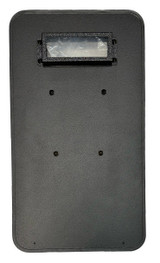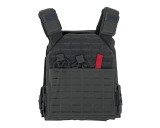What are Types of Armor Plates for Vests - Battle Steel®️
What are Types of Armor Plates for Vests
A 10-minute guide to pros and cons of metal, ceramic and soft plates
Bulletproof vests offer body protection during tactical and military missions. The level of the protection granted depends on specific armor plates inserted into the vest. In this article we explain what are differences between various body armor plates, and provide tips on choosing the appropriate type of armor plates for your bulletproof vest.
Types of body armor plates
According to National Institute of Justice, there are five protection levels of body armor depending on armor performance against certain types of threats. These are:
- Type IIA. 9mm FMJ RN; .40 Smith and Wesson (S&W) FMJ.
- Type II. 9mm FMJ RN; .357Magnum JSP.
- Type IIIA. .357 SIGFMJ FN; .44 Magnum SJHP.
- Type III. 7.62mm FMJ (M80) (Rifle).
- Type IV. .30 Cal AP (M2 AP) (Rifle)
The first three levels are considered soft armor, while the remaining two are hard armor. Soft body armor plates are designed for concealed wear of the bulletproof vest and offer reliable protection against a range of standard bullet threats like pistols. Hard armor plates offer protection also against rifles and are designed to wear over uniform.
Let’s take a closer look at how these armor plates differ.
Soft plates armor
Soft plates for body armor are made of multiple layers of high-strength fiber. The number, composition, and order of fiber layers have an effect on the overall efficiency of the soft armor. The principle of operation of soft armor plates is basically “catching” a bullet into a fiber web. Since fibers are extremely tear-resistant, the impact energy of the bullet is redistributed along the fibers, while the bullet itself deforms (mushroomize). As a result, the penetration strength of the projectile is greatly reduced, and so is the injury. However, as the fiber “catches” the bullet, it deforms in the direction towards the body of the wearer. Hence, the energy of the impact while not penetrating anymore, still can deliver serious damage to internal organs and tissues resulting in injuries and even death. That is why soft armor plates cannot mitigate shots from rifles or large-caliber bullets.
Soft armor plates are:
- Type IIA. This is the lightest armor plate designed to protect against 9mm FMJ RN or .40 Smith and Wesson (S&W) FMJ. It is lightweight, and therefore allows for higher mobility of a wearer. Also, such soft armor type is ideal for concealed wearing.
- Type II. A balanced lightweight soft armor plate designed to keep an ideal compromise between mobility and protection. The Type II armor plate reliably stops 9mm FMJ RN and .357Magnum JSP.
- Type IIIA. This protection type is recommended for the most universal protection against standard bullet threats including but not limited to 357 SIGFMJ FN or .44 Magnum SJHP.
Advantages of soft armor plates:
- The key advantage of soft armor is its low weight. Currently, modern soft body armor plates can easily weight as low as 3 lbs! Low weight means higher mobility, easier aiming and shooting, less fatigue etc.
- Also, soft plates are suitable for concealed wearing which is crucial for undercover operations as well as for guards in public places and other types of wearers who would prefer not demonstrating their protective garment to everyone.
Disadvantages of soft armor plates:
- Soft armor plates for body vests cannot protect from heavy bullets like 7.62x51 NATO or 7.62x39 MSC.
- Typically, a soft armor plate can take 2-3 shots at maximum. After that it needs replacement.
Ceramic plates armor
Hard armor is constructed from ceramic materials, or metal, or both (composite). Ceramic ballistic plates are designed to break the bullet apart and as a result to greatly reduce its penetration and traumatic potential. Ceramic armor is hard and can easily rip the incoming bullet to pieces at the cost of damage done to the ceramic layer itself. The resulting protection is type III or IIIA.
- Type III. This protection is hard enough to raise reliable defense against shots from AK47. The Type III armor plates can withstand 7.62 mm NATO FMJ (M80) too.
- Type IV. This level of hard ceramic body armor plate can protect against the most dangerous threats: rifles, shotguns and assault weapons. A bulletproof vest with inserted ceramic plates of Type IV can withstand .30 Caliber M2 AP shots.
Advantages of ceramic armor plates:
- Superior protection against bullets. Modern ceramic body armor plates are much harder than the steel ones and can withstand much greater impact without deformation. This means that ceramic armor plates can stop even high-speed sniper rifle bullets!
- Relatively low weight. Ceramic is lighter than steel, so ceramic armor is suitable for a wide range of wearers including female wearers. Low weight also reduces fatigue which can be crucial during continued operations.
Disadvantages of ceramic armor plates:
- Lower durability. While ceramic armor delivers very good protection against pistol and rifle shots, the durability of ceramic plates is their weak point. A ceramic armor cannot handle precision shots in the same spot of the armor very well. This is due to the fragile structure of ceramic – it is hard enough to break a bullet to pieces, but the plate breaks in the process too, so next bullets shot in the same area will likely to deal more damage. Eventually, the armor in that point will not offer enough protection.
- Bulky. Ceramic armor plates are lighter than the steel ones, but this comes for a price. In fact, to deliver reliable protection ceramic armor plates are made thicker. Hence, the vest with inserted ceramic plates is a bit bulkier. This sometimes may hinder mobility or aiming of the wearer.
- Higher price. Prices for ceramic armor plates are typically higher compared with steel, but the difference is not dramatic. Taking into account other advantages of ceramic armor, it is a tie.
Metal plates armor
Hard armor with inserted metal plates is one of the oldest bulletproof vest designs. Steel plates are much harder than the material of the bullet, and they also have some plasticity. Upon hit, the steel plate deforms and therefore redistributes the energy of the bullet over larger area. As a result, penetration strength of the bullet is dissipated and cannot do much harm to the wearer of the bulletproof vest with steel plates. Metallic body armor plates are made of steel, and sometimes titanium or titanium hybrid alloys.
Steel plates for body armor offer the following levels of protection:
- Type III. A typical level of protection guaranteed by almost any steel body armor plate. This protection level means the armor plates can withstand 7.62 mm x 51 NATO FMJ (M80), 7.62 mm x 39 MSC and other high-speed bullets.
- Type III+. This is not an official NIJ threat class, but many steel plates are designed to withstand more damage than the Type III implies. For example, steel armor plates can handle M193 shots or shots from AK74.
- Type IV. The uttermost level of protection according to the National Institute of Justice. Steel armor plates certified as Type IV can withstand one hit of an armor-piercing bullet like .30 AP.
Advantages of steel plates for body armor:
- Extra durability. Steel armor plates for vests are very durable and can reliably stop multiple shots. Metal is not destroyed in the process, but merely deformed, so the plate remains functional and still offers protection although with lower efficiency.
- Reliability. Steel does not wear out, it is not fragile like ceramics, and it has excellent shelf life. Hence, an armor reinforced with steel armor plates is ready to serve for years without much maintenance.
- Affordability. Steel armor plates are more affordable compared to ceramic armor plates and composite armor. This means you can get premium protection for less. Titanium alloy armor plates are not that cheap, however.
Disadvantages of armored steel plates:
- Weight. Steel is steel. It’s metal, it’s heavy. On average, a bulletproof vest with inserted steel armor plates weighs two times more compared to a ceramic vest of comparable efficiency. Weight affects mobility and makes steel plate armor unsuitable for some wearers and some applications.
- Low absorption capability. Steel is hard and rigid, and therefore delivers very good protection. But the other side of the coin is that a steel plate is bad at damping the impact. The vest scatters the energy of the bullet, but then it still passes through the plate to your body. The result? Blunt injuries, broken ribs and damaged internals. With high-enough energy of the bullet, the wearer of the armor can be knocked out completely although alive.
- Possible bouncing of a bullet. After a bullet hits the steel plate, it or its pieces can bounce in random directions delivering secondary damage. While front or back shots are not particularly dangerous in this sense, side shot bullets may ricochet to your arm and render you incapable of firing, for example.
How to choose the best armor plate option
Feel puzzled? Ok, here is a simple summary to make sure you select the best armor plate option for your bulletproof vest.
Safety is the major priority when choosing the type of the armor plate for your vest. That is why you should always consider the conditions under which the armor will be worn:
- type of operations
- expected threat type
- required mobility
- whether concealed wear is a must, and other factors.
The requirement for concealed wearing and hand gun threats means your choice is soft plates armor. Steel armor plates are a versatile, reliable and affordable protection in many situations. Ceramic armor plates are for superior protection in many situations, but you still need to take the threat type into consideration.
Wild guesses is a bad way to select the best armor plate type for your vest. After all, your health and life depend on the vest’s protection. Make sure to contact Battle Steel®️ specialist if you have any questions or need assistance in selecting a proper armor plate type.
Recent Posts
-
Understanding Ballistic Shield Ratings and Their Applications
The Trusted Name in Tactical Defense - BattleSteel® When it comes to protecting those who protect us …2025-04-19 -
The Importance of Hearing Protection in Tactical Environments
The Legacy of BattleSteel® BattleSteel® is a trusted name in the world of tactical defense equipment …2025-04-14 -
How to Properly Fit and Wear a Plate Carrier
About BattleSteel and Their Mission BattleSteel is a trusted name in the tactical gear industry, ren …2025-04-11


